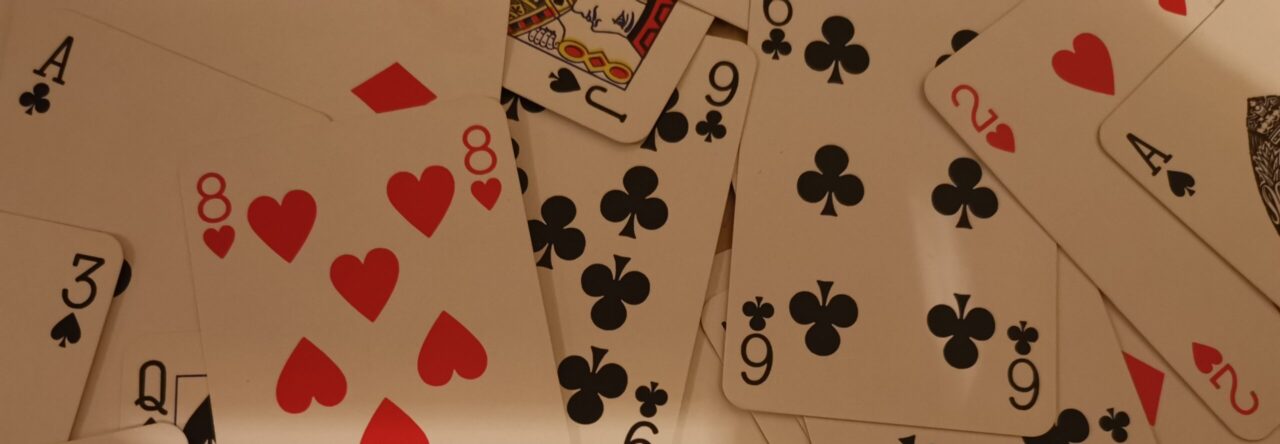This bid is used after an opening bid of 2NT showing 20-22 points where it can contain a 5 card major. It’s used to find a 5-3 or 4-4 fit in the majors and also to get the strong hand to play out the contract.
After reading these notes…take a look at the muppet stayman video to further reinforce your understanding of the subject (19 hands included).
3♣ is muppet Stayman with the following responses.
| Bid | Meaning |
| 3♦ | I have at least one 4 card major |
| 3♥ | I don’t have a 4 or 5 card major |
| 3♠ | I have a 5 card spade suit |
| 3NT | I have a 5 card heart suit |
So this is the interesting thing about Muppet Stayman compared to Puppet Stayman – the 3♥ and 3NT bid are switched around.
Continuation after 3♦
The responses are similar to puppet stayman.
| Bid | Meaning |
| 3♥ | Asks how many spades |
| 3♠ | I have a 4 card heart suit |
| 3NT | To play |
| 4♣ | Both majors with slam interest |
| 4♦ | Both majors no slam interest |
| 4♥ | Slam interest in clubs |
| 4♠ | Slam interest in diamonds |
The 3♥ is an ask just in case partner (the hand opposite the 2NT opener) had started with 5 spades and 3 hearts. Rather than transfer to spades and give up on finding a 5-3 heart you will go through muppet stayman.
| Bid | Meaning |
| 3♠ | I have a 3 card spade suit (4 hearts and 3 spades) |
| 3NT | I have a 2 card spade suit (4 hearts and 2 spades) |
| 4♣ | I have 4 spades and potential slam interest |
| 4♠ | 4 spades no slam interest |
After 4♣, suit bids are cue bids apart from 4♥ which is a relay to 4♠ and 4NT is RKCB…5♥ and 6♥ would be further relays to spades if need be.
Continuation after 3♥ (showing no 4/5 card major)
| Bid | Meaning |
| 3♠ | Relay to 3NT |
| 3NT | Shows a 5 card spade suit (very easy to forget!) |
| 4♣ | 5-5 Both majors slam interest |
| 4♦ | 5-5 Both majors no slam interest |
| 4♥ | Slam interest in clubs (6+ card suit) |
| 4♠ | Slam interest in diamonds (6+ card suit) |
Continuations after 4♣ (5/5 Majors slam interest)
So after 2NT – 3♣ – 3♥ – 4♣ or 2NT – 3♣ – 3♦ – 4♣
| Bid | Meaning |
| 4♦ | RKCB in hearts |
| 4♥ | To play – bottom end of your hand |
| 4♠ | To play – bottom end of your hand |
| 4NT | RKCB in spades |
Continuations after opener bids 3NT (showing 5 hearts)
| Bid | Meaning |
| Pass | To Play |
| 4♣ | Undisclosed minor (or diamonds?) |
| 4♦ | Puppet to 4♥ then 4NT is RKCB |
| 4♥ | ? Could be used as a slam try in clubs |
| 4♠ | Cue Bid |
| 4NT | Quantitative no hearts |
Because 4♦ is a puppet you cannot bid that to show diamonds.
Continuations after opener bid 3♠ (has a 5 card spade suit)
| Bid | Meaning |
| 3NT | To play |
| 4♣ | Constructive natural (could show diamonds) |
| 4♦ | Constructive natural (could show clubs) |
| 4♥ | Slam try in spades |
| 4♠ | To Play |
| 4NT | Quantitative |
After a 3NT relay response
So after 2NT – 3♣ – 3♥ – 3♠ – 3NT – ?
| Bid | Meaning |
| 4♣ | Natural Slam try in Diamonds (5 card suit) |
| 4♦ | Natural Slam try in Clubs (5 card suit) |
| 5NT | Pick a slam – looking for a 4-4 minor fit |
By playing it this way opener can play a slam in diamonds which might be more advantageous.
Opener bids 4NT to sign off or bids the next suit up to agree a slam in the agreed minor.
It’s really critical you discuss this as a lot of people play this the wrong way and as soon as they here 4NT they start answering RKCB…you shouldn’t play it this way in the minors…use a suit bid to agree a minor slam interest.
Next suit up can then be RKCB (4130) or you can cue bid. Again make sure you agree.
After 4♥ to show slam interest in clubs
So after 2NT – 3♣ – 3♥ – 4♥
| Bid | Meaning |
| 4♠ | RKCB agreeing clubs (4130) |
| 4NT | To play |
After 4♠ to show slam interest in diamonds
So after 2NT – 3♣ – 3♥ – 4♠
| Bid | Meaning |
| 4NT | To play |
| 5♣ | RKCB in diamonds (3041) |
Muppet Transfers
So if you have 5 spades and 4 hearts you can bid 3♣ where you can find a major fit – don’t use transfers with this holding like you normally would.
But! When you hold 5 hearts and 4 spades transfer to hearts first and then bid 3NT to show this hand with no interest in slam.
If you find muppet stayman too difficult (understandable) for you…or you think you might forget it then take a look at puppet stayman instead.
